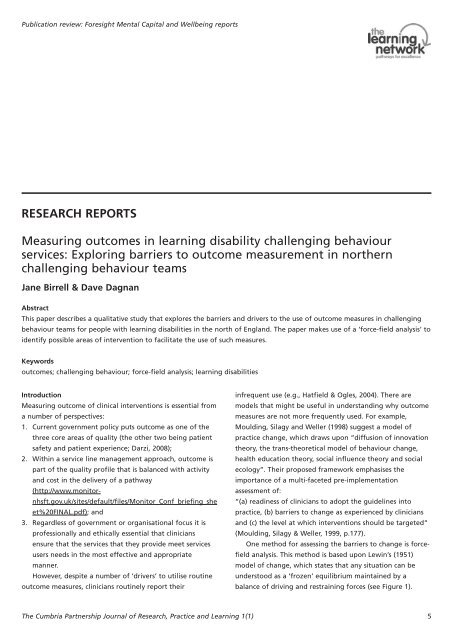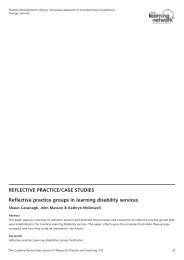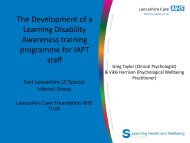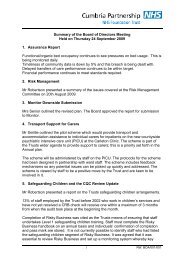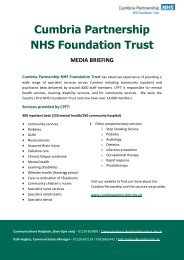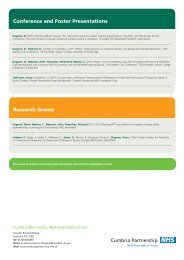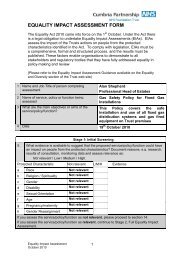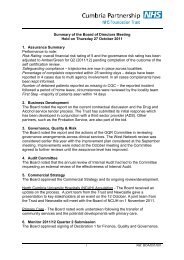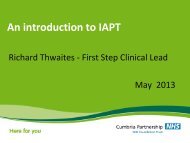RESEARCH REPORTS Measuring outcomes in learning disability ...
RESEARCH REPORTS Measuring outcomes in learning disability ...
RESEARCH REPORTS Measuring outcomes in learning disability ...
You also want an ePaper? Increase the reach of your titles
YUMPU automatically turns print PDFs into web optimized ePapers that Google loves.
Publication review: Foresight Mental Capital and Wellbe<strong>in</strong>g reportsAffiliationsProfessor Dave Dagnan, Consultant Cl<strong>in</strong>ical Psychologist &Cl<strong>in</strong>ical Director, The Learn<strong>in</strong>g Network, Cumbria PartnershipNHS Foundation TrustContact <strong>in</strong>formationProfessor Dave Dagnan, dave.dagnan@cumbria.nhs.ukReferencesFor all reports associated with the project go tohttp://www.bis.gov.uk/foresight/our-work/projects/currentprojects/mental-capital-and-wellbe<strong>in</strong>g/reports-andpublicationsBedd<strong>in</strong>gton, J., Cooper, C. L., Field, J., Goswami, U., Huppert,F. A., Jenk<strong>in</strong>s, R., Jones, H. S. et al. (2008). The mental wealthof nations. Nature, 465, 1057-1060. Retrieved December 1,2010,http://www.bis.gov.uk/assets/bispartners/foresight/docs/mental-capital/ment0al-wealth-nations-nature.pdf<strong>RESEARCH</strong> <strong>REPORTS</strong><strong>Measur<strong>in</strong>g</strong> <strong>outcomes</strong> <strong>in</strong> learn<strong>in</strong>g <strong>disability</strong> challeng<strong>in</strong>g behaviourservices: Explor<strong>in</strong>g barriers to outcome measurement <strong>in</strong> northernchalleng<strong>in</strong>g behaviour teamsJane Birrell & Dave DagnanAbstractThis paper describes a qualitative study that explores the barriers and drivers to the use of outcome measures <strong>in</strong> challeng<strong>in</strong>gbehaviour teams for people with learn<strong>in</strong>g disabilities <strong>in</strong> the north of England. The paper makes use of a ‘force-field analysis’ toidentify possible areas of <strong>in</strong>tervention to facilitate the use of such measures.Keywords<strong>outcomes</strong>; challeng<strong>in</strong>g behaviour; force-field analysis; learn<strong>in</strong>g disabilitiesIntroduction<strong>Measur<strong>in</strong>g</strong> outcome of cl<strong>in</strong>ical <strong>in</strong>terventions is essential froma number of perspectives:1. Current government policy puts outcome as one of thethree core areas of quality (the other two be<strong>in</strong>g patientsafety and patient experience; Darzi, 2008);2. With<strong>in</strong> a service l<strong>in</strong>e management approach, outcome ispart of the quality profile that is balanced with activityand cost <strong>in</strong> the delivery of a pathway(http://www.monitornhsft.gov.uk/sites/default/files/Monitor_Conf_brief<strong>in</strong>g_sheet%20FINAL.pdf); and3. Regardless of government or organisational focus it isprofessionally and ethically essential that cl<strong>in</strong>iciansensure that the services that they provide meet servicesusers needs <strong>in</strong> the most effective and appropriatemanner.However, despite a number of ‘drivers’ to utilise rout<strong>in</strong>eoutcome measures, cl<strong>in</strong>icians rout<strong>in</strong>ely report their<strong>in</strong>frequent use (e.g., Hatfield & Ogles, 2004). There aremodels that might be useful <strong>in</strong> understand<strong>in</strong>g why outcomemeasures are not more frequently used. For example,Mould<strong>in</strong>g, Silagy and Weller (1998) suggest a model ofpractice change, which draws upon “diffusion of <strong>in</strong>novationtheory, the trans-theoretical model of behaviour change,health education theory, social <strong>in</strong>fluence theory and socialecology”. Their proposed framework emphasises theimportance of a multi-faceted pre-implementationassessment of:“(a) read<strong>in</strong>ess of cl<strong>in</strong>icians to adopt the guidel<strong>in</strong>es <strong>in</strong>topractice, (b) barriers to change as experienced by cl<strong>in</strong>iciansand (c) the level at which <strong>in</strong>terventions should be targeted”(Mould<strong>in</strong>g, Silagy & Weller, 1999, p.177).One method for assess<strong>in</strong>g the barriers to change is forcefieldanalysis. This method is based upon Lew<strong>in</strong>’s (1951)model of change, which states that any situation can beunderstood as a ‘frozen’ equilibrium ma<strong>in</strong>ta<strong>in</strong>ed by abalance of driv<strong>in</strong>g and restra<strong>in</strong><strong>in</strong>g forces (see Figure 1).The Cumbria Partnership Journal of Research, Practice and Learn<strong>in</strong>g 1(1) 5
<strong>Measur<strong>in</strong>g</strong> <strong>outcomes</strong> <strong>in</strong> learn<strong>in</strong>g <strong>disability</strong> challeng<strong>in</strong>g behaviour servicesTable 1: Scores allocated to issues encourag<strong>in</strong>g implementation of outcome measures (driv<strong>in</strong>g forces)Level Item Score Total ScoreIndividualPersonal Professional Development 36Desire to observe improvement for clients/feedback to self 38Drive to improve team performance/<strong>in</strong>crease team cohesion 33Direct <strong>in</strong>teraction with clients/carersNeed to provide feedback to clients/carers 21Desire to improve the quality of service provided to clients/carers 24Need to promote the role of the practitioner/team 10OrganisationalPolicy 25Service changes/redesign 33Need to demonstrate effectiveness and efficiency 42Government/wider fieldResearch/<strong>in</strong>creas<strong>in</strong>g evidence base 10Government pressures/legislation 1828Total Score 29010755100Similarly to the driv<strong>in</strong>g forces, the restra<strong>in</strong><strong>in</strong>g forces at the<strong>in</strong>dividual level were endorsed more strongly that those atany other level. The score for the <strong>in</strong>dividual level restra<strong>in</strong><strong>in</strong>gforces (141) was significantly higher than the score for the<strong>in</strong>dividual level driv<strong>in</strong>g forces (107). The client-based andwider barriers were considered least important, obta<strong>in</strong><strong>in</strong>gscores of 41 and 20 respectively. The items that achieved thehighest scores were <strong>in</strong>dividual level items, <strong>in</strong>clud<strong>in</strong>g a lack ofknowledge and skills (41) and a lack of time (43).Interest<strong>in</strong>gly, the overall score for driv<strong>in</strong>g forces (290) issignificantly higher than that for the restra<strong>in</strong><strong>in</strong>g forces (203).Table 2: Scores allocated to issues prevent<strong>in</strong>g implementation of outcome measurement (restra<strong>in</strong><strong>in</strong>g forces)Level Item Score Total ScoreIndividualLack of knowledge/skills 41Lack of time 43Individual attitudes 28Differences <strong>in</strong> cl<strong>in</strong>ical practice 18Team dynamics 11141Direct <strong>in</strong>teraction with clients/carersDifferences <strong>in</strong> <strong>outcomes</strong> prioritised 7Complexity of work<strong>in</strong>g with these clients 16Jo<strong>in</strong>t-work<strong>in</strong>g with private and other providers 1841OrganisationalLack of funds/resources 34Pressure for turnover 7Service design issues 18Chang<strong>in</strong>g priorities 1271Government/wider fieldLack of priority/<strong>in</strong>terest <strong>in</strong> this field 5Lack of evidence for <strong>in</strong>dividual measures 12Complexity of the field 320Total Score 203The Cumbria Partnership Journal of Research, Practice and Learn<strong>in</strong>g 1(1) 7
<strong>Measur<strong>in</strong>g</strong> <strong>outcomes</strong> <strong>in</strong> learn<strong>in</strong>g <strong>disability</strong> challeng<strong>in</strong>g behaviour servicesDiscussionThis study has described the use of force-field analysis toidentify barriers and drivers to the rout<strong>in</strong>e implementationof outcome measurement <strong>in</strong> learn<strong>in</strong>g <strong>disability</strong> challeng<strong>in</strong>gbehaviour teams. The analysis has shown that teams identifythe drivers and barriers that have the strongest effects, andthe biggest discrepancy between drivers and barriers, asbe<strong>in</strong>g at the level of the <strong>in</strong>dividual cl<strong>in</strong>ician and <strong>in</strong>dividualcl<strong>in</strong>ical practice. Thus it seems likely that the most effectivepo<strong>in</strong>ts to <strong>in</strong>tervene to change practice would be those at thelevel of the <strong>in</strong>dividual cl<strong>in</strong>ician.One of the most frequently cited barriers to change atthe <strong>in</strong>dividual level was a lack of knowledge and skillssurround<strong>in</strong>g the use of outcome measures. It is, therefore,suggested that regular tra<strong>in</strong><strong>in</strong>g <strong>in</strong> the use of particularmeasures would be highly beneficial. It may be helpful todraw upon the exist<strong>in</strong>g knowledge and experience with<strong>in</strong>staff teams. In this way, groups of cl<strong>in</strong>icians could be tra<strong>in</strong>edto use new measures on a regular basis, by members with<strong>in</strong>the team who are familiar with and/or rout<strong>in</strong>ely useparticular measures. It is proposed that such methods wouldenhance the knowledge and skills of the cl<strong>in</strong>icians, but alsothat observ<strong>in</strong>g examples of the use of measures by theircolleagues would build confidence and staff cohesion.Individual attitudes to change were identified as an<strong>in</strong>trapersonal barrier to improv<strong>in</strong>g rout<strong>in</strong>e outcomemeasurement. Thus, it may be useful for cl<strong>in</strong>icians to beprovided with a forum <strong>in</strong> which to voice their concerns andfears (such as at the shared practice day at which thisresearch was conducted) and to discuss difficulties <strong>in</strong> us<strong>in</strong>goutcome measures with colleagues and peers. Theidentification of a named cl<strong>in</strong>ician with some knowledge, aparticular <strong>in</strong>terest or significant experience <strong>in</strong> us<strong>in</strong>g outcomemeasures to which colleagues could br<strong>in</strong>g queries andconcerns may help to overcome some of the negativeattitudes towards this particular change <strong>in</strong> practice.Factors at other psychosocial levels that mightparticularly merit <strong>in</strong>tervention <strong>in</strong>clude further strengthen<strong>in</strong>gof the driver “need to demonstrate effectiveness andefficiency” and challeng<strong>in</strong>g a perceived “lack of resourcesand funds”. It is possible that these two issues (both ofwhich score highly <strong>in</strong> terms of their impact upon the currentequilibrium) could be l<strong>in</strong>ked <strong>in</strong> help<strong>in</strong>g the teams explorethe efficiencies possible as a result of good quality outcomeassessment that might demonstrate the “resource value” ofoutcome measurement systems.This paper has described the use of force-field analysis asa method to exam<strong>in</strong>e the challenges around the<strong>in</strong>troduction of effective outcome measurement. The paperhas provided important <strong>in</strong>sights <strong>in</strong>to cl<strong>in</strong>ical understand<strong>in</strong>gof this issue. It is suggested that the method is a useful tool<strong>in</strong> develop<strong>in</strong>g understand<strong>in</strong>g of organisational issues and <strong>in</strong>produc<strong>in</strong>g implementation plans based upon the experienceof participants.AffiliationsJane Birrell, Cl<strong>in</strong>ical Psychologist, Cumbria Partnership NHSFoundation TrustProfessor Dave Dagnan, Consultant Cl<strong>in</strong>ical Psychologist &Cl<strong>in</strong>ical Director, The Learn<strong>in</strong>g Network, Cumbria PartnershipNHS Foundation TrustContact <strong>in</strong>formationProfessor Dave Dagnan, dave.dagnan@cumbria.nhs.uk.Key ReferencesBritish Psychological Society (2004). Psychological<strong>in</strong>terventions for severely challeng<strong>in</strong>g behaviours shown bypeople with learn<strong>in</strong>g disabilities: Cl<strong>in</strong>ical Practice Guidel<strong>in</strong>es.Leicester: BPSDagnan, D. (2007). Psychosocial <strong>in</strong>terventions for peoplewith learn<strong>in</strong>g disabilities. Advances <strong>in</strong> Mental Health andLearn<strong>in</strong>g Disabilities, 2, 3-7.Darzi, A. (2008). High quality care for all: NHS next stagereview f<strong>in</strong>al report. London: Department of Health.Hatfield, D. R., & Ogles, B. M. (2004). The use of outcomemeasures by psychologists <strong>in</strong> cl<strong>in</strong>ical practice. ProfessionalPsychology, 35, 485-491.Lew<strong>in</strong>, K. (1951). Field theory <strong>in</strong> social science. New York:Harper & Row.Mould<strong>in</strong>g, N. T., Silagy, C. A., & Weller, D. P. (1999). Aframework for effective management of change <strong>in</strong> cl<strong>in</strong>icalpractice: Dissem<strong>in</strong>ation and implementation of cl<strong>in</strong>icalpractice guidel<strong>in</strong>es. Quality <strong>in</strong> Health Care, 8, 177-183.West, M. A., & Farr, J. L. (1989). Innovation at work:Psychological perspectives. Social Behaviour, 4, 15-30.8 The Cumbria Partnership Journal of Research, Practice and Learn<strong>in</strong>g 1(1)


